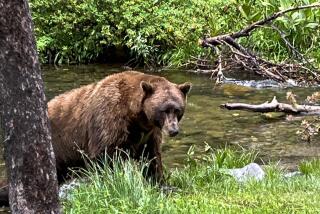Monkey chatter smacks of human speech, researcher says
Are monkeys talking behind our backs? That creepy “Planet of the Apes” sensation struck University of Michigan researcher Thore Bergman when he heard the lip-smacking sounds of wild geladas, a baboon-like primate found in the Ethiopian highlands.
Bergman analyzed the sounds, and suggests they may represent an evolutionary link between primate communication and human speech. His report is published in the journal Current Biology.
“I would find myself frequently looking over my shoulder to see who was talking to me, but it was just the geladas,” said Bergman. “It was unnerving to have primate vocalizations sound so much like human voices.”
Scientists have been focusing on the sounds and facial rhythms of primates for some time, trying to discern how we may have moved from chattering to chatting as we advanced along the path toward homo sapiens.
Macaques and rhesus monkeys, for example, appear to exhibit rhythmic facial movements and sounds that are evocative of human speech patterns, researchers have found.
But Bergman says previous work failed to demonstrate that monkey sounds occurred at the same time as their rhythmic facial movements, and lacked the tonal qualities of human speech. His analysis of gelada lip-smacking calls, however, showed that the facial movements occurred simultaneously, and that the rhythm was similar to that of humans.
“It demonstrates that nonhuman primates can vocalize while lip-smacking to produce speech-like sounds,” Bergman said. While this may not be proof of how human speech developed, it makes such an evolutionary path “at least plausible,” he said.
Bergman listened to what he described as a “wobble,” a sound he said was produced from simultaneous production of a moan and lip-smacking that males made during “affiliative interaction” with females, who tend not to make similar sounds.
It’s probably a long way from such sounds and the stuff guys talk about on dates, but Bergman says it’s “a promising analog to human speech.”







